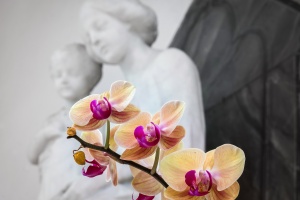 In 2020, the Shepherds of the Church gave us a treasure in the new Directory for Catechesis. Dr. Farey was a member of the working party for the bishops on the new Directory and shares additional reflections on its practical implications in this conclusion of the three-part series.
In 2020, the Shepherds of the Church gave us a treasure in the new Directory for Catechesis. Dr. Farey was a member of the working party for the bishops on the new Directory and shares additional reflections on its practical implications in this conclusion of the three-part series.
There are many small ways by which beauty can be brought into one’s catechesis easily and simply, even if finding beautiful images or music are not one’s forte. The new Directory for Catechesis urges us “that every form of catechesis . . . attend to the ‘way of beauty.’”[i] Beauty was mentioned in a single footnote in the Directory of 1997. In the directory of 2020, however, it is noted as one of the essential criteria for catechesis (DC 175) and even as a “source” of catechesis (DC 109); yet few catechists or resources give beauty its due place.
The catechizing power of beauty was especially brought to the fore by Pope John Paul II and Pope Benedict XVI, but they each took up the insight of Pope Paul VI, who famously said “This world in which we live needs beauty in order not to sink into despair.”[ii] Too many in today’s world are sinking into despair and the most popular remedy is “fun” rather than beauty. Fun is fleeting, even though it has a proper place, while “a thing of beauty is a joy forever.”[iii] Catechists need to trust more in the deeper, quieter power of beauty as a “voice” by which God in his love reaches the heart.
A key problem is that the secular worldview has led most people to believe that beauty is in the eye of the beholder, that beauty is only one’s personal opinion. The directory helpfully provides criteria for discernment of what is true beauty, which it distinguishes from what is “apparently beautiful but empty, or even harmful, like the forbidden fruit in the earthly paradise (cf. Gn 3:6)” (DC 108). In other words, beauty is objective; there are criteria for discerning it so that we can train the eyes of our minds towards it. The criteria given are from St. Paul: “whatever is true, whatever is honorable, whatever is just, whatever is pure, whatever is lovely, whatever is gracious, if there is any excellence, if there is anything worthy of praise, think about these things” (Phil 4:8; cf. DC 108).
Let us “think about these things” for the resources we find, the rooms and spaces we use, our presentations, our invitations, and our language. How often do we use the words “beauty” and “beautiful” for God, the faith, and the things pertaining to the Christian life? A person’s modesty, honesty, wisdom, forgiveness, reception of grace, the goodness, kindness, and courage of the saints, every fruit of the Spirit (Gal 3:22), “a life of fidelity to the Gospel”[iv]—these are, and need to be, called beautiful. The directory speaks also of that which is “[gratuitous], free of functionalism” as well as of “order and harmony” (DC 106).
Many argue that teenagers engage best via the kind of graphics, music, language, and concepts taken from the fractured, post-modern, functional, soundbite world around them. The directory tells us otherwise.
Most insistently, the directory proposes using the great Catholic historical and artistic heritage. This heritage is found at its zenith in the fifteenth century at a height of maturation of Catholic Christian culture. Art of the fifteenth century tends, therefore, to be some of the most profoundly beautiful, richly depicting scriptural truth. By 1517, the Protestant Reformation had begun, and the arts reacted in consequence.
There are powerful catechetical reasons given in the directory for using the Catholic cultural artistic heritage. First, “It transmits the Christian vision of the world” (DC 105), a vision that is beautiful rather than ugly, whole rather than fragmented, aiming at excellence rather than portraying brokenness, depicting goodness rather than sin or degradation. It also tends to reveal an ecclesial and eucharistic vision of creation and redemption.
Secondly, beauty develops and preserves the “faculties of contemplation and observation which lead to wisdom.”[v] Often, the ancient artworks do not appear understandable or beautiful to the modern mindset. We need to learn contemplation by practicing it on something that gradually reveals its meaning, its depths, its richness. Such art is not immediately understood or grasped and cannot be judged by an immediate, superficial impression.
Is the faith beautiful for you? Do you pass it on as something beautiful, honorable, just, true, good? Using beauty as a guide “leads those who are catechized toward the beautiful gift that the Father has made in his Son” (DC 109).
Dr. Caroline Farey has been training catechists for twenty-five years and currently runs the online course “Foundations of the Faith for the New Evangelisation” at www.theannunciation.org.uk. Each unit demonstrates teaching through beauty.
Notes
[i] Pontifical Council for the Promotion of the New Evangelization, Directory for Catechesis (Washington, DC: USCCB, 2020), no. 108 (hereafter cited in text as DC), quoting Pope Francis, Evangelii Gaudium, no. 54.
[ii] Pope Paul VI, “Message to Artists,” 1965.
[iii] John Keats, “Endymion,” bk. 1, ln. 1.
[iv] Evangelii Gaudium, no. 168, quoted in DC 84.
[v] Vatican II, Gaudium et Spes, no. 56.
This article originally appeared on page 20 in the print edition.
Art credit: Public domain photo of orchid with statue of Madonna and child in the background by Thomas B. from Pixabay.com.
